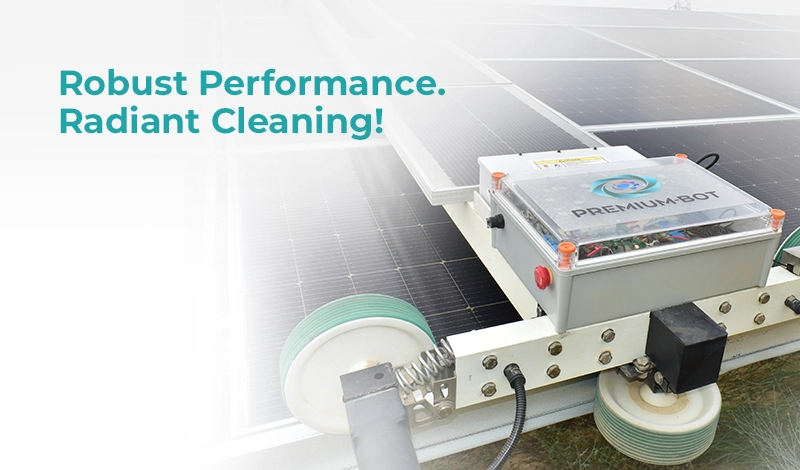
Manual or Automatic Cleaning: Which One Really Fits Your Solar Site?
If you run a ground-mounted solar plant, you already know dust, bird droppings, and even city smog aren’t just small annoyances; they quietly eat into your revenue. A thin layer of grime can reduce efficiency way faster than owners expect, and suddenly, generation numbers don’t look anything like the PVsyst projections.
At first, cleaning might feel straightforward: a few workers, some brushes, plenty of water. But when you scale up – say, a 50 MW site spread across acres with lakhs of panels – cleaning turns from a maintenance task into a serious operational strategy. Water use, labor shortages, safety, and costs all start coming into play.
That’s why the debate between manual cleaning and automated robotic systems has become so important. Let’s look at what each one really brings to the table.
Why Keeping Panels Clean Matters
A lot of owners don’t think much about soiling after commissioning. The panels are up, the site looks fine – and unless the numbers crash, cleaning doesn’t get much focus. But here’s the catch: rain alone doesn’t clear out stubborn dirt, especially in arid zones like Rajasthan, where dust piles up daily.
We’ve seen sites where just one cleaning boosted output by more than 20%. That kind of jump shows how much energy is quietly being lost when panels aren’t maintained.
Pvsyst simulations often cap soiling losses at 2%. But in real desert conditions, losses of 5% or more are common. Robotic cleaning has shown it can cut that number closer to 1%, keeping actual yield much closer to projections.
Brushes and Buckets: Why Manual Cleaning Struggles at Scale
Using water, brushes, and crews works fine if you’re running a small or easy-to-reach site. Teams can get the job done while also checking wiring and doing small fixes.
But once you stretch across hundreds of acres, the problems start stacking up:
- Too manpower-heavy – Finding enough workers in remote areas is difficult.
- Water guzzler – A 50 MW site can drink up around 1 lakh liters for just one cleaning cycle. In deserts, this is simply not sustainable.
- Diesel bills grow – Tankers and crew transport mean recurring fuel costs.
- Safety issues – Long hours under the blazing sun aren’t ideal for workers.
For big solar parks, manual cleaning feels outdated – too expensive, too risky, and too dependent on resources.
Robotic Cleaning: Smarter, Cleaner, and Much Easier
Robotic cleaners are built with one thing in mind: keeping your panels spotless without all the usual hassle. Depending on the system, they might use motor-driven brushes, small sprayers, or even operate completely without water.
Here’s why plants are switching:
- Runs on its own schedule – Cleaning can happen at night or after dusty periods without crews.
- Big water savings – Many systems use 70–90% less water. Some are fully dry.
- Low manpower need – Remote monitoring means fewer people on site.
- Saves diesel – No more endless tanker trips.
- Predictable output – Soiling loss cut to ~1% means energy yield stays more stable.
Costs? For a 50 MW setup, usually 4–5 robots per MW are enough. Payback typically lands in about 2–3 years, after which the system just keeps delivering savings and steady generation.
Manual vs. Robots: The Real Trade-Offs
Here’s the practical lens most operators use:
| Factor | Manual Cleaning | Robotic Cleaning |
|---|---|---|
| Startup Cost | Low | Moderate |
| Labor | High, tough to source | Minimal, remote-managed |
| Safety | Exposed crews | Safer, no daily presence |
| Water Use | 1 lakh liters/cycle | 70–90% less (or dry) |
| Diesel Use | High | Very low |
| Consistency | Uneven, schedule-based | Clockwork-cleaning |
| Output | Variable, soiling loss 5%+ | Stable, ~1% loss |
| ROI | Hard to measure | 2–3 years |
So really, it isn’t just about which one can clean – it’s about which one keeps your plant running efficiently without burning through people, water, and fuel.
Are Robots Right for Every Site?
Small rooftop or compact ground-mount projects? Manual still works fine. But the moment you’re in dusty, dry, or remote terrain, the math shifts. Robotic cleaning cuts out a lot of recurring headaches—labor shortages, water scarcity, and unnecessary diesel bills.
At one of our Premium Group projects, switching to automated cleaning boosted daily energy output by 18% while slashing water truck trips. That’s the kind of change you feel both in your revenue numbers and your sustainability reports.
Beyond Cleaning: Meeting Sustainability Goals
It’s not just about power generation anymore. ESG reporting and sustainability tracking now matter to investors and regulators. Robotic systems help by:
- Saving tens of thousands of liters of water per cleaning cycle.
- Cutting diesel use and associated emissions.
- Digitally logging every cleaning cycle for audits.
This mix of higher yield and lower resource use is why robotics is quickly becoming the default for utility-scale plants.
Wrapping It Up: Cleaning Is About More Than Clean Panels
Truth is, dirty panels don’t just look bad—they drain money. Manual cleaning has its place, but once you’re operating at scale, it’s like trying to wash a stadium with a garden hose.
Robotic systems take away the headache, bringing consistency, water savings, and a clear return on investment. If your site is ready to grow smart instead of adding more manual effort, it’s worth considering the robotic route.






